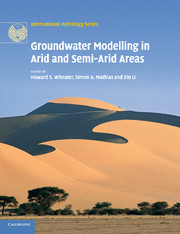Book contents
- Frontmatter
- Contents
- Contributors
- Preface
- Acknowledgements
- 1 Groundwater modelling in arid and semi-arid areas: an introduction
- 2 Hydrological processes, groundwater recharge and surface-water/groundwater interactions in arid and semi-arid areas
- 3 Conceptual models for recharge sequences in arid and semi-arid regions using isotopic and geochemical methods
- 4 Groundwater flow and transport
- 5 Performing unbiased groundwater modelling: application of the theory of regionalised variables
- 6 Groundwater vulnerability and protection
- 7 Variable density groundwater flow: from modelling to applications
- 8 Sustainable water management in arid and semi-arid regions
- Index
- Plate section
- References
8 - Sustainable water management in arid and semi-arid regions
Published online by Cambridge University Press: 06 December 2010
- Frontmatter
- Contents
- Contributors
- Preface
- Acknowledgements
- 1 Groundwater modelling in arid and semi-arid areas: an introduction
- 2 Hydrological processes, groundwater recharge and surface-water/groundwater interactions in arid and semi-arid areas
- 3 Conceptual models for recharge sequences in arid and semi-arid regions using isotopic and geochemical methods
- 4 Groundwater flow and transport
- 5 Performing unbiased groundwater modelling: application of the theory of regionalised variables
- 6 Groundwater vulnerability and protection
- 7 Variable density groundwater flow: from modelling to applications
- 8 Sustainable water management in arid and semi-arid regions
- Index
- Plate section
- References
Summary
INTRODUCTION
As a result of the ever-growing global population, pressure on water resources is increasing continuously, above all in arid and semi-arid regions. In many cases, the presently applied management practices are non-sustainable and lead to serious water-related problems such as the depletion of aquifers, the accumulation of substances to harmful levels, to water conflicts or economically infeasible costs. In this contribution, we illustrate these problems with several case studies. The northwest Sahara aquifer system is used to show the consequences of the overpumping of aquifers. A typical upstream–downstream problem is discussed with the example of the Okavango delta. Another case study discussed is the Yanqi basin in China. The Yanqi basin is a typical example showing how inappropriate irrigation practices can lead to soil salinisation and ecological problems of the downstream. Possible solutions to these problems and the role of numerical modelling as a tool to develop sustainable management practices are discussed. Some of the most common problems in setting up reliable models are highlighted and ideas how to address these problems are given. In the last part of this chapter, we discuss strategies to close the existing gap in thinking between scientists and decision makers.
DEFINITION OF SUSTAINABLE WATER MANAGEMENT
In a pragmatic definition, sustainable water management describes a practice which prevents irreversible damage to the resource water and resources related to it such as soils and ecosystems and which preserves in the long-term the ability of the resource to extend its services (including ecological services).
- Type
- Chapter
- Information
- Groundwater Modelling in Arid and Semi-Arid Areas , pp. 119 - 130Publisher: Cambridge University PressPrint publication year: 2010
References
- 4
- Cited by



